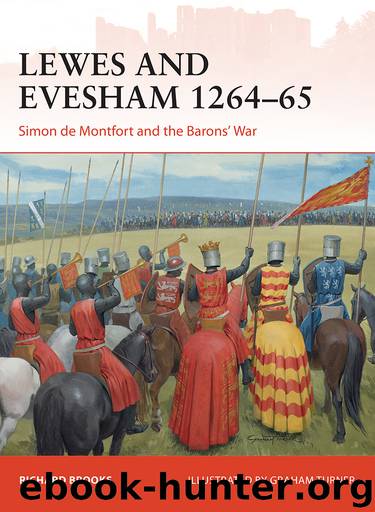Lewes and Evesham 1264-65 by Richard Brooks

Author:Richard Brooks
Language: eng
Format: epub
ISBN: 9781472811523
Publisher: Osprey Publishing
Published: 2015-04-25T16:00:00+00:00
The Norman arch through which Edward’s men marched out of Lewes Castle. Even the small numbers described in the text would need a couple of hours to defile through the narrow gateway. (Postcard from author’s collection)
Dispositions are better documented. Several contemporaries describe the royalists in three bodies, the rebels in four. Rishanger’s Chronicle is typical:
Edward, the King’s eldest son, commanded the first battle, with William de Valence, Earl of Pembroke, and John de Warenne, Earl of Surrey and Sussex. The second, the king of Germany [Richard of Cornwall] with his son Henry; the third King Henry himself. The barons’ army was divided into four battles. The first of which Henry de Montfort and the Earl of Hereford [actually his son] commanded; the second Gilbert de Clare, with John fitzJohn and William of Munchensy; the third, in which were the Londoners, Nicholas of Seagrave; the fourth Earl Simon led himself, with Thomas of Pelvestone.
Guisborough adds that Guy de Montfort accompanied the rebels’ first battle, demonstrating the presence of reinforcements from the Midlands. Wykes describes Edward’s division as the flower of the army. Including Lusignans and Marchers, it was a glittering retinue for the royal family’s rising star. If his wing was really 700 strong, Edward had half the royalist cavalry. The three leading divisions of each army are enumerated right to left, placing Edward opposite the Londoners. Leaving the castle via the gatehouse into Western Road, he would naturally find himself on the right, relegating his father and uncle from the priory to the less honourable left and centre. Suggestions that Simon cynically placed the Londoners in Edward’s path appear far-fetched.
Modern accounts agree that Simon held his fourth division behind the others as a reserve. His co-commander’s London connections suggest this division also included troops from the capital. The royal army had no reserve, having left 20 banners at Tonbridge. Assuming ten to 20 men-at-arms each, these might have mustered 300 riders, perhaps explaining the difference between the Canterbury and Trinity figures. Some modern accounts claim reserves were unusual in medieval battles. This is quite untrue. William Marshal had used reserves to win his tournaments; at Lincoln he effectively held three-quarters of his army in reserve, forming his four divisions in column.
Some accounts describe the royalists as surprised, hurried into action piecemeal. Wykes says Henry had believed the rebels unlikely to venture anything against him. Guisborough says ‘the king had not considered the barons’ approach so imminent’, but the context suggests any surprise was more strategic than tactical. Royalist foragers, gathering hay on the Downs, roused their masters in time not just to arm themselves, but to foregather in the priory and seal a document. Rishanger suggests a prompt rather than disorderly response: ‘The king, indeed, and his army … having realised [the rebels’] sudden appearance, awoke the more swiftly to put on their arms, and having drawn up their battle lines for fighting, spread their banners, one with a royal device threatening death, which was called the ‘Dragon’, [and] advanced with a monstrous great noise of trumpets’.
Download
This site does not store any files on its server. We only index and link to content provided by other sites. Please contact the content providers to delete copyright contents if any and email us, we'll remove relevant links or contents immediately.
| Africa | Americas |
| Arctic & Antarctica | Asia |
| Australia & Oceania | Europe |
| Middle East | Russia |
| United States | World |
| Ancient Civilizations | Military |
| Historical Study & Educational Resources |
The Radium Girls by Kate Moore(10914)
The Templars by Dan Jones(4192)
100 Deadly Skills by Clint Emerson(4084)
Rise and Kill First by Ronen Bergman(4016)
The Doomsday Machine by Daniel Ellsberg(3736)
The Rape of Nanking by Iris Chang(3522)
Killing England by Bill O'Reilly(3459)
Hitler in Los Angeles by Steven J. Ross(3443)
Stalin by Stephen Kotkin(3089)
12 Strong by Doug Stanton(3059)
Hitler's Monsters by Eric Kurlander(2736)
Darkest Hour by Anthony McCarten(2650)
Blood and Sand by Alex Von Tunzelmann(2611)
The Art of War Visualized by Jessica Hagy(2416)
Hitler's Flying Saucers: A Guide to German Flying Discs of the Second World War by Stevens Henry(2298)
The Code Book by Simon Singh(2214)
The Second World Wars by Victor Davis Hanson(2136)
Babylon's Ark by Lawrence Anthony(2073)
Tobruk by Peter Fitzsimons(2064)
